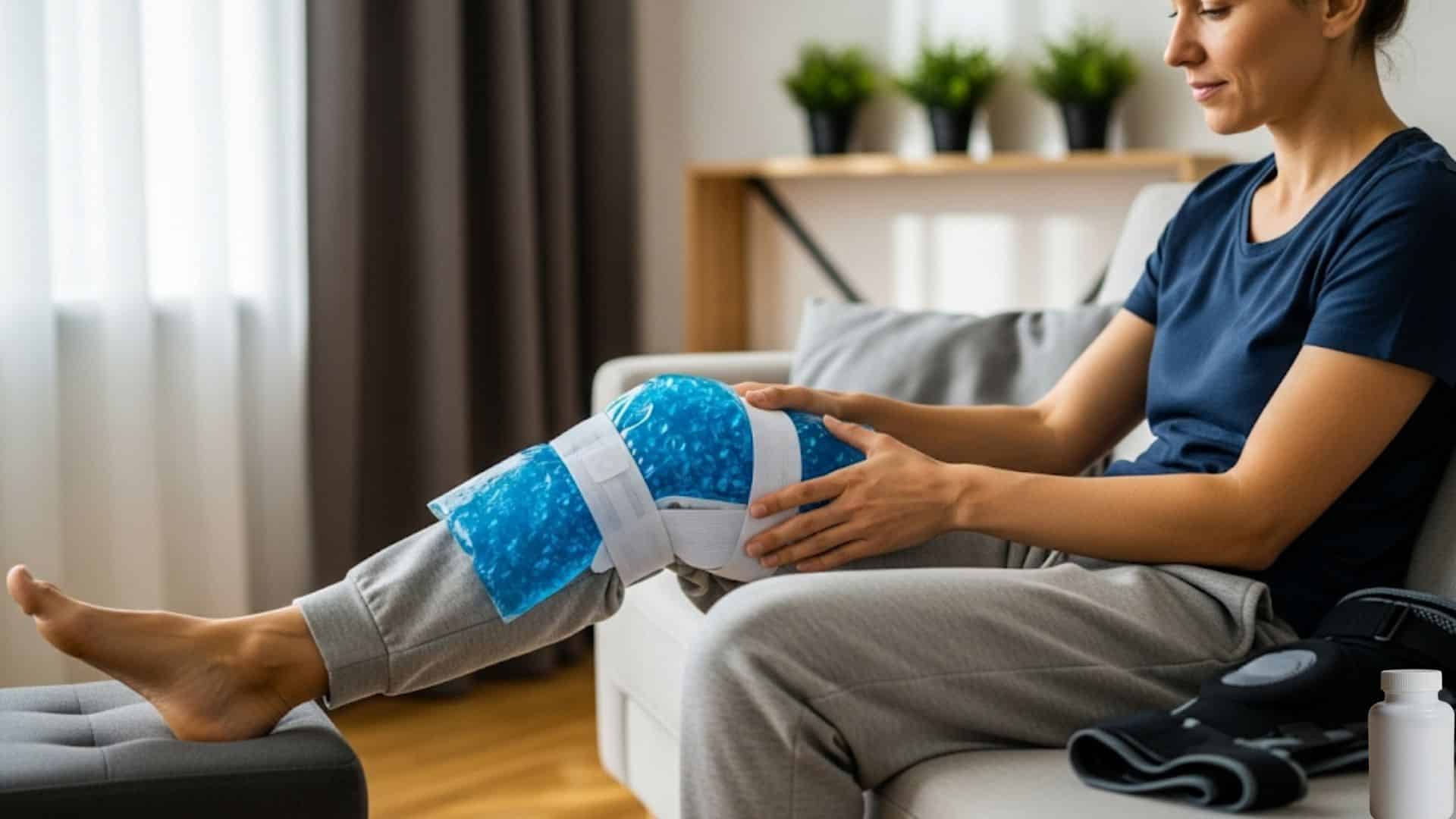When I first looked into MCL sprains, I realized how crucial this ligament is for maintaining the knee’s stability and safety during everyday movements.
Learning about the MCL sprain symptoms helped me see why catching them early is so important for healing the right way.
For you, spotting those signs can give you a head start on care. If you know what to watch for and when to see a doctor, you’ll feel more in control of your recovery.
The right information means fewer doubts and a clearer path to regaining full strength in your knee. I’ll show you how to recognize these important indicators and understand your treatment options.
Obtaining accurate information enables you to make informed decisions. Don’t let confusion about your injury delay proper care and healing.
What is an MCL Sprain?
The Medial Collateral Ligament, or MCL, is a key ligament that stabilizes the inside of your knee. It connects the thigh bone to the shin and helps keep your knee steady during movement.
Sprains occur when this ligament is stretched too far or torn, resulting in pain and instability.
Brigham and Women’s Hospital provides detailed guidelines for diagnosing and treating MCL sprains. These guidelines offer expert care standards that you can trust for reliable information about this injury.
Trusted sources, such as the Cleveland Clinic, also provide thorough explanations of symptoms, diagnosis, and treatment options, guiding patients through their recovery process.
Recognizing MCL Sprain Symptoms
MCL sprain symptoms can vary depending on how badly you injured your knee ligament.
Recognizing these warning signs helps you understand the severity of your injury and when to seek help:
1. Physical Pain and Discomfort
Pain is often the first and most noticeable of the common MCL injury symptoms. The location and intensity of pain can help indicate how severe your sprain might be:
- Pain specifically on the inner side of your knee that worsens with movement or pressure.
- Sharp or aching sensations that increase when you try to bend or straighten your leg.
- Tenderness when you touch the area along the inner knee ligament.
- Pain that may radiate slightly above or below the knee joint area.
This pain typically appears immediately after injury or develops within the first few hours. The intensity often corresponds with the severity of the ligament damage you’ve sustained.
2. Visible Signs and Swelling
Physical changes to your knee’s appearance can provide important clues about the severity of your injury. These visible symptoms usually develop shortly after the initial trauma occurs:
- Swelling around the inner knee area appears within hours of injury.
- Bruising or discoloration around the inner knee, especially with more severe sprains.
- Noticeable puffiness or enlarged appearance compared to your uninjured knee.
- Skin that feels warm or tight around the injured ligament area.
These visible signs help medical professionals assess the extent of tissue damage. Documenting how quickly these symptoms appear can be valuable information for your healthcare provider.
3. Movement and Stability Issues
Functional problems with knee movement often indicate the severity of ligament damage. These symptoms can significantly impact your daily activities and mobility:
- Stiffness or reduced range of motion that makes bending your knee difficult.
- Feeling of instability where your knee feels wobbly or might “give out.”
- Difficulty bearing weight on the affected leg during walking or standing.
- A popping sound at the time of injury that you or others might hear clearly.
Movement problems usually become apparent immediately after injury but may worsen over the first day.
Obtaining a thorough medical evaluation helps determine the most effective treatment plan for your unique situation.
Common Causes of an MCL Sprain
MCL sprains happen when your knee gets forced inward beyond its normal range of motion.
Understanding these common causes helps you recognize risky situations and take steps to protect your knee:
1. Sports-Related Impacts
Sports like football, soccer, and basketball often cause MCL sprains. A direct hit or tackle pushes the knee inward, stretching or tearing the ligament.
These contact sports involve sudden stops and collisions, making the MCL vulnerable.
Players frequently experience pain, swelling, and instability in the knee after such impacts. Proper protective gear and training can help reduce the risk of these injuries.
2. Sudden Changes in Direction or Twisting of The Knee
Quick turns or twisting motions stress the MCL by forcing the knee sideways. This can happen while running, jumping, or cutting, especially on uneven surfaces.
Such sudden movements can stretch or tear the ligament, causing pain and difficulty walking. Athletes should warm up well and strengthen muscles to improve knee stability and avoid injuries.
3. Falls or Direct Blows to The Outside of The Knee
Falling or getting hit on the outer side of the knee pushes it inward too forcefully. This sudden force can damage the MCL, causing sprains or tears.
Falls during sports or everyday activities are common causes. Immediate pain, swelling, and tenderness are warning signs requiring a medical check-up.
How Doctors Diagnose an MCL Sprain
Doctors typically begin with a hands-on examination. They’ll gently move and press on your knee to check for pain, swelling, or tenderness along the inner side.
They also perform stress tests, where the knee is pushed slightly inward to see if the ligament holds steady or feels loose. These steps show how badly the MCL may be injured.
If a fracture or other knee problem is suspected, the doctor may order an X-ray to confirm the diagnosis.
To see the soft tissues in detail, an MRI scan is often used. It gives a clear picture of the ligament and any surrounding damage.
Receiving an early and accurate diagnosis enables more effective treatment and facilitates a faster recovery.
Combining a careful exam with imaging gives doctors a complete view of your injury, so they can recommend the best plan for recovery and protect your long-term knee function.
Care and Recovery for MCL Sprains

MCL sprain treatments usually start with simple at-home care methods that you can begin right away.
More severe injuries may require medical intervention and professional guidance from healthcare providers. Here are some treatment options you can consider:
At-Home Care
At home, the RICE method is the best way to start healing an MCL sprain.
- Rest means avoiding activities that cause pain.
- Ice helps reduce swelling and numbs pain; apply for 15-20 minutes every 2-3 hours.
- Compression, like using an elastic bandage, controls swelling.
- Elevation means keeping your knee raised above heart level to reduce swelling.
Over-the-counter pain relievers such as ibuprofen can help ease discomfort.
These simple steps reduce inflammation and promote faster healing without much risk. Starting care early at home often helps prevent worsening of the injury and supports quicker recovery.
Medical Treatments
Healthcare providers offer several treatment options depending on the severity of your MCL sprain. These medical approaches help speed up healing and prevent further damage to your knee:
- Bracing or knee supports help keep the knee stable during healing
- Physical therapy strengthens muscles around the knee and improves balance
- Surgery is rarely needed, but may be required for severe tears or multiple ligament injuries
Following medical advice closely helps ensure proper healing and reduces the risk of long-term problems.
Recovery Timeline for MCL Injury and What to Expect
MCL sprain recovery time depends on how severely you injured the ligament in your knee. Knowing these timelines helps you set realistic expectations and plan for your return to normal activities:
| Grade | Recovery Time | Treatment Focus | What to Expect |
|---|---|---|---|
| Grade 1 | A few weeks | Proper rest and basic care | Mild pain, minimal swelling, quick return to activities |
| Grade 2 | 4-6 weeks | Physical therapy and rehabilitation | Moderate pain, noticeable swelling, gradual activity return |
| Grade 3 | Several months | Intensive rehab, possible surgery | Severe pain, significant instability, extended recovery |
Recovery times can vary depending on your age, overall health, and adherence to treatment recommendations.
Rushing back to activities too soon often leads to reinjury and longer recovery periods.
Prevention Tips for MCL Injuries
Protecting your knee before it gets hurt is always easier than recovering from an injury.
Consistent, thoughtful care can dramatically lower your risk of medial collateral ligament (MCL) sprains, both in sports and daily life.
1. Warm Up Before Any Activity
Always start with 5–10 minutes of light activity, such as brisk walking, cycling, or gentle jogging, before engaging in sports or exercising.
Warm muscles and tendons are less likely to strain. Add dynamic stretches such as leg swings or walking lunges to improve blood flow and prepare the knee for movement.
2. Strengthen Supporting Muscles
Your MCL gets extra protection when the muscles around it are strong. Focus on exercises that build your quadriceps, hamstrings, glutes, and core.
Squats, step-ups, bridges, and planks all support better knee alignment and absorb impact during movement.
3. Improve Flexibility and Balance
Tight muscles and poor coordination increase stress on the knee. Include regular stretching for your hamstrings, calves, and hip flexors to keep the joints moving smoothly.
Balance drills, such as single-leg stands or using a wobble board, train your body to react quickly and remain stable during sudden changes in direction.
4. Wear Protective Gear When Needed
If you play contact sports or have a history of knee injuries, consider wearing a supportive knee brace or sleeve.
These help limit sideways stress on the MCL and provide extra stability. Make sure your shoes fit well and are designed for your activity to reduce slipping or twisting.
5. Use Proper Technique
Poor form can overload the knee. Learn and practice correct landing, cutting, and pivoting techniques in your sport or exercise routine.
Working with a coach, trainer, or physical therapist can help correct movement patterns that increase injury risk.
6. Listen to Early Warning Signs
Don’t ignore mild pain, swelling, or stiffness around the knee. Taking a short break, adjusting your training, or using ice early on can prevent a small problem from turning into a serious sprain.
Building strength, flexibility, and proper movement habits takes time, but it’s far less stressful than months of rehab after an injury.
Consistent care keeps your knees stable, resilient, and ready for whatever activity you enjoy.
Wrapping It Up
When I started learning about MCL sprain symptoms, it gave me the confidence to make smarter choices about my own knee health.
Knowing what to watch for also helped me recognize when it was time to see a doctor.
For you, catching the signs early can mean faster healing and fewer problems later on. Following the right treatment plan will not only help with recovery but also protect your knee from future issues.
If you’re unsure, reaching out to a sports medicine or orthopedic specialist is always a smart move.
Your ability to stay active depends on how you handle injuries now. I’d love to hear from you; share in the comments which treatment approach feels most helpful for your situation!





